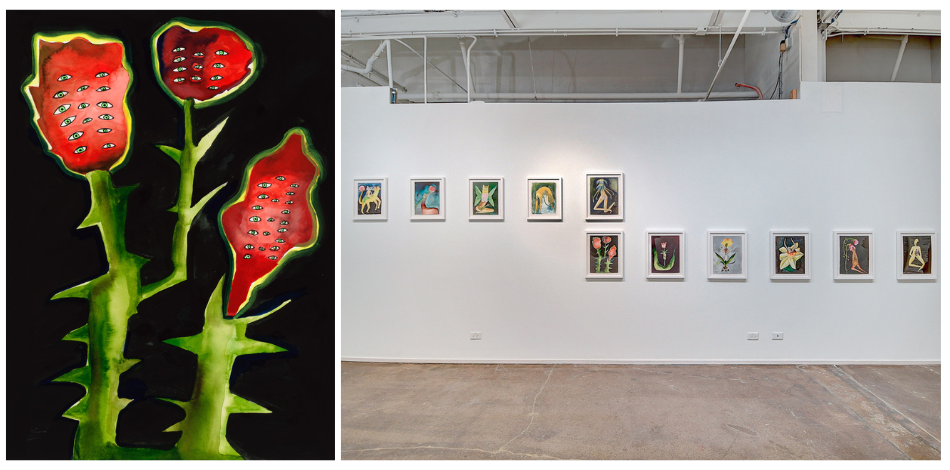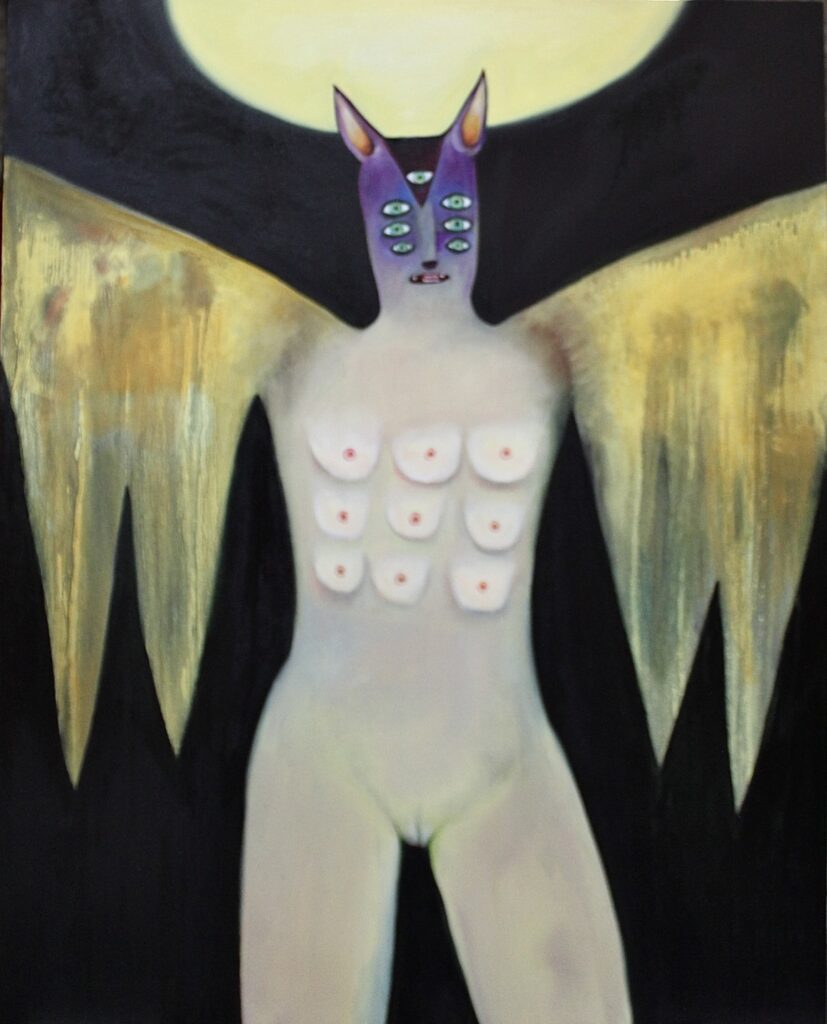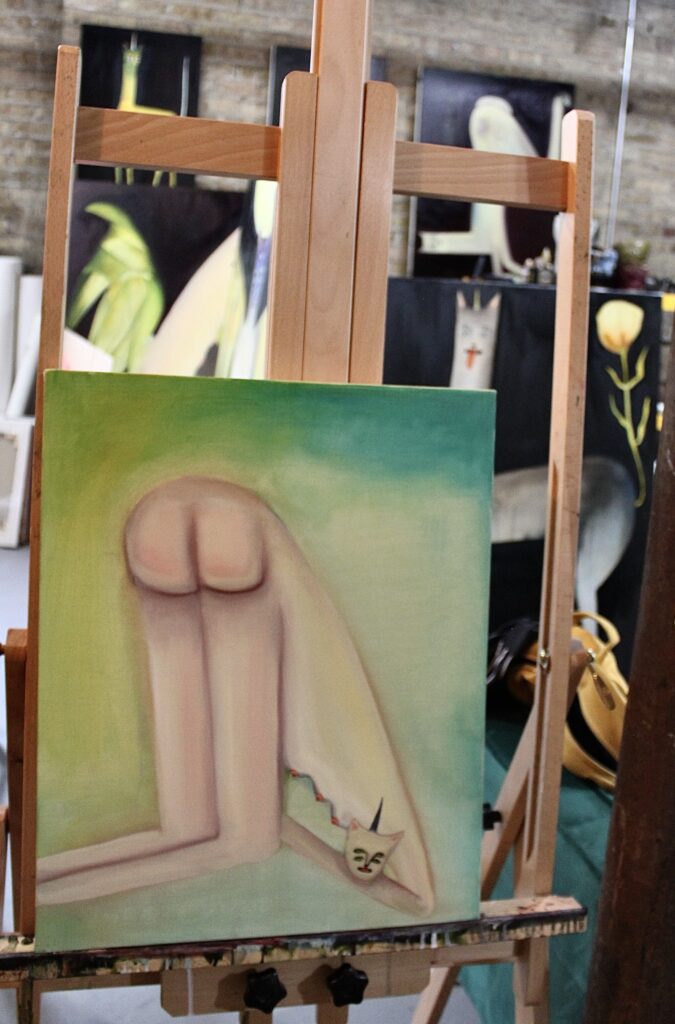Jessie Mott is a Senior Program Officer at the Reva and David Logan Foundation, working with our Arts and Social Justice grantees. In addition, she manages our winter wear and school supplies distributions, as well as other special initiatives. Outside of her work with the Foundation, Jessie is an accomplished visual artist whose work spans an array of media, including drawing, painting, and collaborative projects. Her practice focuses on themes of identity and power by exposing unstable perceptions of the queer body. Jessie’s work has been exhibited widely, including in the International Film Festival Rotterdam and the Whitney Biennial.
Communications Coordinator Sabrina Boggs interviewed Jessie at her studio to learn more about her career as an artist, her upcoming shows, and her philosophies on being an artist and artist care.

When did you first get into art and decide to pursue it as a career?
Jessie: It started when I was young as an emotional outlet. I’m an only child and I spent a lot of time alone, so I would spend days drawing, making up creatures and naming them. Since early childhood, I have extremely vivid dreams and nightmares about animals—usually trying to save them in some capacity. Continuing into adulthood, it looks like stuffing half-dead ferrets with cigarette burns on their bodies in my coat in the subway; finding a thrashing two-headed unicorn abandoned for years in a university science lab dumpster; my body growing long hair, turning into a dog; giving birth to a hamster.
I went to NYU and majored in studio art. I loved the program but didn’t have much confidence. I didn’t think that I’d be able to support myself as an artist, so I always did other things in addition to my art making—fundraising, development, nonprofit work. I was living in New York City and cost of living was crazy, but I never stopped painting. I ended up making pet portraits for a living at one point.
It’s when I moved to Chicago that I started taking myself more seriously as an artist. I got an MFA from Northwestern, and that opened up a lot of doors, personally and professionally. I’m really grateful for that experience.
What are the inspirations for your work today?
Jessie: My work examines sexuality, power and vulnerability inherent in the permeable boundaries of human/animal, corporeal/fantastical and gender categories.
These queer bodies with their otherworldly anatomies offer sites for projection, like some kind of abject fairy tale. Tension is created by negotiating the contrast between interior worlds and the realities of external representation and exposure. Queens, mentors, mothers—figures revered, feared, and desired, embody a complexity that invites viewers to locate themselves in the flux of what is ethereal and what is tangible.
Rarely deviating from a vertical format, the images may be read as portraits. The figures often appear isolated, located in a densely colored background of non-space. When shown together, the accumulation offers various levels of interpretation about the collective gaze. Multiple eyes disrupt a traditional narrative of seeing and being seen. Ambiguous bulges suggestive of breasts—are they nurturing, erotic, and/or suffocating lumps?
I’m constantly asking myself, what are the creatures doing, why are they doing this, why do I portray them this way, how do they need to transform? In my mind I always have a non-linear narrative. I want the work to be accessible and honest. I’m still learning what my work is about.
Tell us more about your dual life outside of art.
Jessie: My passion for social justice work is intertwined with my artistic life. I have worked in a variety of community-based health settings, including Test Positive Aware Network (TPAN) for many years. My role mostly involved grant writing and other development related work, but I was also very interested in working in collaboration with people, doing direct service. I co-led an art group for people living with/vulnerable to HIV. I have a passion for social justice and find a lot of meaning when I connect with people, so I decided to get a Master in Social Work, thinking I might become a mental health clinician. Soon, though, the program got me thinking more about macro-practice, working towards systemic change. I was curious about philanthropy, having been on the grant writing side for so long. I was learning about power and money, how to move money to create power, and how much power you can have by burning down a system from within.
Richard Logan came to my philanthropy class to speak. I really admired the passionate sense of urgency, creativity, and problem solving that he expressed. It’s something artists try to do too—come up with creative solutions to problems. After the talk I told him I was going to work for him and basically harassed him until he hired me. It was a good decision.

Do you think that art needs to have meaning?
Jessie: Yes. Even if you try not to, your art will have meaning due to the choices you make, materials you choose, venue you choose to present… You can’t escape the context in which you’re working. Everyone has to go through a process. It can be so vulnerable to show your work. Here you are sitting with a painting for six months, just you and this work, and then all of a sudden it’s in the world and people can think and say whatever they want about it. And you don’t have any control over that.
What outside influences are present in your art?
Jessie: As a child I used to pore over nature books and magazines. I was obsessed with animals, and I always had nature books about North American mammals and stuff like that. And if you look at all the pictures, there’s these kind of intense anatomical images. Everything’s out there! And it’s normal because it’s an animal body. But then when you paint it, people start asking, well why did you do that?
I am inspired by artists like Louise Bourgeois, Maria Lassnig, Carol Rama, Karen Kilimnik, Nicole Eisenman. I definitely spent a lot of time in the Met and Art Institute of Chicago looking at small sculptures from Java in the 13th century, old masters paintings, Goya and Rembrandt.
In 2001 I took a painting class at NYU with this amazing artist/person Maureen Gallace, who was very much a nurturing figure in my life. I was supposed to have class the morning of 9/11/01 and got to campus (from Brooklyn) early that day. By the time I got to Union Square I saw the second tower fall. Once students went back to classes (I don’t even remember how long we were out of school), Maureen told us to make a painting about the period of time. I brought in a photo of a deer I’d seen on the beach that summer. I found her majestic yet vulnerable. With the sea behind her and her legs impossibly long. How does she even walk? How does she hold herself up with these legs, this body?
Can you talk more about your upcoming solo exhibition at Goldfinch?
Jessie: I called the show Pluto. I love the myth about Persephone, although it’s a terrible story. Pluto abducted Persephone and took her to the underworld, and for six months out of the year her mother Hera mourned for her, creating a barren winter. When her daughter came to the surface for the other 6 months, there was spring.
Pluto is usually considered to be a powerful male. In my re-interpretation, they are both, but mostly female. Pluto, in astrology, is about death and rebirth. That’s really central to the work—transformation, physically and spiritually.
There are 12 new oil paintings in the show.
Where do you want to go from here?
Jessie: Collaboration has become a large part of my practice. Since 2009, I have made cartoons with the artist and writer Steve Reinke. I have an ongoing collaboration called “Like Queer Animals” with the writer and queer scholar Chantal Nadeau (our current exhibition at CAC runs 5/29-6/27). I also am collaborating with artist and musician Diane Christiansen (our current exhibition is in the Drawing Room of The Arts Club of Chicago running 5/13-September). Since 2020 I have been mailing drawings back and forth to Dutes Miller (our current show is up at Drawing Room Invitational at Lump Projects in Raleigh, NC).
Collaboration helps me loosen up, think differently, and use different materials. I like to keep things fresh and fun. I want to keep making work and showing it. That in itself is a gift. I want to grow my artist community. I have a really good group of friends who are really supportive. For me, it’s about community and always thinking, feeling, and making.
Not that I’ve had a lot of commercial “success”, but because of the kind of work I make, I can sell things. I don’t want to be dependent and make a living off my art because I want to have creative freedom. Also, I adore my work at the Foundation—I find it really meaningful (while providing me the ability to survive!).
I’m content with where I am. If you really are ambitious and think you have to have a show at this museum, or this gallery, or be represented by so and so… That can lead to a lot of disappointment and feelings of failure. You’re being susceptible to external validation to feel like you’re worth something. I try not to fall in those traps.
What do you realistically want to see change in the art world and philanthropy?
Jessie: Increased accessibility for artists who are not in the traditional pipelines, or connected to powerful institutions. More community building. Space for radical imagining and dreaming. Using less jargon when writing about art. Be real, be authentic. Why do you make your work? Where does it come from, why are you doing it? The luxury of time and space for artists to think about what they want their work to do in the world. More opportunities for artists to be artists: residencies that accommodate all bodies, family structures, childcare. Artists need to be paid for their labor, they need healthcare, they need to not be exploited. It would be a very sad world without artists. They need to be celebrated and compensated. I suggest reading the Threewalls Thriving Wage Report.
Can you talk more about what it costs to make art?
Jessie: Not only do you need space to create your work (depending on the kind of work you make), you have to pay for that on top of your rent, utilities, and the cost of materials (life in general). When I choose to make oil paintings, sometimes one tube of paint is $50 per tube. For canvases as well… hundreds of dollars. And I can actually sell my work because it is easily commodified, whereas artists working with conceptual, performance, moving image practices often have to rely on grants. Where is the time to do that? Also, art school debt! And then if you end up getting a job where you’re paid well, sometimes you don’t have time to make your work, so you have to make choices. And especially so if you are helping to support others—family, caregiving, etc … Oh, and in a school or hospital setting when there are budget constraints, art is usually the thing that gets cut first.
Do you have any advice for emerging artists, or artists who are balancing a full-time job and their practice?
Jessie: There are a lot of ways to look at it. I always chose the stability of having a full-time job because, even though I don’t have as much time to create, not having to worry about my next paycheck makes me more creative. Whereas, when you are cobbling together various gigs, you have some freedom with your time but you might be stressed about how to pay your rent, buy materials, or even enjoy yourself.
You have to get really creative around how you structure your time: what’s for you, what’s for them, and how you protect your mind space. Have enough time to contemplate life, contemplate your work, relax, sleep, nurture yourself. You have to figure out what feels right for you, and what you’re willing to do. Do you need a separate space, can you work from your home? Do you need to get up earlier in the morning so you can meditate, write, read a book, or think about your work? I know I don’t do well in the nighttime because I’m too tired from the day. So I get up early, and that time is just for myself.
I keep a sketchbook with me wherever I go. I write down my dreams. I write down and take pictures of things I find inspiring, and I look back at them a lot. I also keep a draft in my Gmail of the year, and anytime something significant happens, I write it down, and then look back to see what was important to me, and what came of the things I wrote down. That has helped me shape how I want to structure my future.
I think a lot about how I would write my autobiography (not that I’m going to). What was my life about? What matters to me? At the end of the day, when you’ve had your last breath—what was important to you? What are your values? When you make and show your work, what makes you feel good or not good about that? Who is the work for? If your dream is to go to Switzerland and become a circus performer, what are the steps you realistically have to take to get there? Constantly ask yourself questions.
Visit Jessie’s summer exhibitions:
Pluto (solo show of new oil paintings)
Goldfinch
319 N. Albany Avenue, Chicago, IL 60612
Opening: Saturday, June 15, 2024, 2-5pm
Gallery Hours: Fridays and Saturdays from 12-4pm, when exhibitions are on view; and by appointment
Exhibition runs through July 27, 2024
info@goldfinch-gallery.com
Diane Christiansen and Jessie Mott: New Work (including a new animation!)
The Drawing Room at The Arts Club of Chicago
201 E Ontario St, Chicago, IL 60611
Opening: Monday, June 17, 2024, 5:30 – 7:30pm
Exhibition runs through September 2024
information@artsclubchicago.org
Fleurs de Macadam (curated by Vasia Rigou) by Like Queer Animals (Jessie Mott and Chantal Nadeau) with augmented reality by Victor Mateevitsi
Chicago Artists Coalition
2130 W. Fulton St., Chicago, IL 60612
Wed-Thu: 11AM-5PM | Fri-Sat: by advance appointment
Exhibition runs through June 27, 2024
contact@chicagoartistscoalition.org


